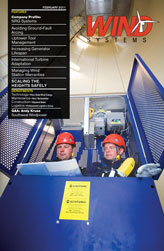In conducting end of warranty inspections, we typically find a number of turbine gearboxes with internal gear damage that occurred over a relatively short period of time. While these issues have materialized largely unnoticed by the project owner up to the final turnover inspection, the affect of such irreversible conditions will gravely impact the performance of the gearbox through future years. Proper lubrication and control of contaminants has never been more important, both during and after the warranty period.
Although many gearbox failures resulting from manufacturing issues have been widely reported lately, damage to gear teeth caused by poor lubrication and maintenance practices continues to be a problem. Improvements in gear materials and gearbox designs unfortunately can’t eliminate contamination that enters gearboxes in a number of ways: metal remnants from the manufacturing process and from internally produced gear and bearing wear, airborne particles through breathers and seals, and particulates that are unintentionally added during maintenance. You can be assured that whenever the gearbox is opened for inspection, top-off, or repair, a significant opportunity exists for contaminant ingress.
While some get away with describing it as normal wear and tear, the scuffing and micropitting issues found after just five years of turbine operation might be more aptly described as abuse and neglect. Normal wear will occur as a result of degradation of the lubricant over time and is expected to occur slowly over the life of the gearbox, given well-filtered oil with no suspended or abrasive particles. Scuffing and pitting, on the other hand, is damage caused directly from contamination of the oil, and from an industry perspective is not generally considered wear at all. Often stated, contamination of the oil is a critical factor in gearbox longevity, and discovering evidence of scuffing or micropitting after just a few years of operation is a smoking gun for establishing responsibility at the end of warranty.
With today’s gearbox designs calling for new surface hardening techniques and metallurgy, the products have led to more aggressive surface loading and ultra-thin surface material. These harder surfaces are more resistant to sliding wear, but they are highly susceptible to contaminant-induced rolling wear. Additionally, the mating surfaces of gear teeth are not perfectly smooth and are full of small imperfections such as machining marks and dents. If the proper viscosity of oil is used, the oil film will be thick enough and the imperfections of the gear teeth will not contact one another. If contamination is introduced, however, hard particles in the oil can fatigue the hardened material in different but easily identifiable ways.
Scuffing is damage to a gear tooth surface due to intense frictional heat generated by a combination of high sliding velocity and high contact stress. Metal particles detach and transfer from the meshing teeth. During successive rotations these particles can scratch the teeth and will continue do to so until the particles are removed from the oil. Micropitting is a form of rolling contact fatigue that can occur anywhere along the tooth surface, typically starting in the bottom or the top of the tooth profile where contact is made. Identified by a gray stain color, micropitting is surface fatigue that results in micro-cracking, formation of micropits, and loss of material. The small pits can be difficult to see, but the condition may lead to macropitting and eventual gear tooth breakage. In either case lubricant and lubricating conditions, not material strength, are responsible for scuffing damage and micropitting. The risk of both increases as lubricating oil degrades or becomes contaminated with particles or water.
Because their moving parts are in contact with each other, all gearboxes essentially require lubrication. Contaminants not only reduce the lubricant’s ability to do its job, but will also interfere with the moving surfaces to cause wear and ultimately lead to component failure. Abrasive deterioration evidenced by scuffing or micropitting will result not only from oil contamination but also by poorly specified lubricants. We all recognize that replacing filters on a regular basis is good maintenance. Refitting gearbox vents with breathers that restrict the ingestion of airborne dirt and debris will help control contamination from entering the unit. Proper care during top-off and inspections will reduce the introduction of particles into the unit. Also keep in mind that overfilling a gearbox can be just as damaging as under-filling, as it can cause air entrainment, overheated oil, and leakage.

































